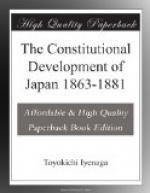II.—EDUCATIONAL INSTITUTIONS.
Previous to the Restoration, the schools supported by Daimios and the private schools were few in number; but since that epoch the educational system has been vastly improved, with a resulting increase in the number of schools and pupils. In 1878, of high, middle, and primary schools there were altogether 27,600, with 68,000 teachers and 2,319,000 pupils.[5] The following table shows the comparative history of educational institutions within three years, 1878-1880 (inclusive):
Teachers. Pupils. Year. Institutions. Male. Female. Male. Female. 1878 27,672 66,309 2,374 1,715,425 610,214 1879 29,362 71,757 2,803 1,771,641 608,205 1880 30,799 74,747 2,923 1,844,564 605,781
Furthermore, hundreds of students went abroad yearly, and returning, powerfully influenced the destiny of their country.
III.—NEWSPAPERS.
It was in 1869 that the Emperor sanctioned the publication of newspapers. Magazines, journals, periodicals and newspapers sprung up in a night. The number of newspapers published in 1882 was about 113, and of miscellaneous publications about 133. It is to be noted that the newspapers defied the old censorship of prohibition under very sanguinary pains and penalties. Their circulation increased every year. The total newspaper circulation in 1874 was but 8,470,269, while in 1877 it was 33,449,529. In his consular report of 1882, Consul-General Van Buren makes an approximate estimate of the annual aggregate circulation of a dozen noted papers of Tokio to be not less than 29,000,000 copies.[6]
The publication of books and translations kept pace with the growth of newspapers. Observing the effects of these literary activities, Mr. Griffis well says: “It is the writer’s firm belief, after nearly four years of life in Japan, mingling among the progressive men of the empire, that the reading and study of books printed in the Japanese language have done more to transform the Japanese mind and to develop an impulse in the direction of modern civilization than any other cause or series of causes.”
Meanwhile, great changes were affecting law and religion. Here it is sufficient to observe that the old law which had been hitherto altogether arbitrary—either the will of the Emperor or of the Shogun—was revised on the model of the Napoleonic code and soon published throughout the land. The use of torture to obtain testimony was wholly and forever abolished.
With the incoming of Western science and Christianity, old faiths began to lose their hold upon the people. The new religion spread yearly. Missionary schools were instituted in several parts of the country. Christian churches were built in almost all of the large cities and towns, and their number increased constantly. Missionaries and Christian schools had no inconsiderable influence in changing the ideas of the people.




